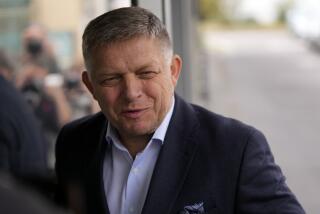Slovak-Hungarian Tensions Burn Economic Bridges
- Share via
STUROVO, Slovakia — Sturovo’s bridge leads nowhere and seems destined to remain that way. It is one more likely victim of tensions between Hungary and newly independent Slovakia--hostility that Slovaks can ill afford.
Already, Slovakia is burdened with an unproductive economy left over from the Communist era, 12% unemployment and lagging Western investment. It also faces all the other financial and political tasks of building a new nation for 5 million people in its part of the former Czechoslovakia.
But historic ethnic tensions, stifled under the Communists, are not waiting for these problems to be solved. They are poisoning relations between Hungary and the new Slovakia, including talks over the restoration of the bridge destroyed in World War II.
To Sturovo’s mostly Hungarian inhabitants, the bridge has become a symbol of Slovak-Hungarian relations.
A new bridge was low on the priority list during four decades of “Communist brotherhood” between Czechoslovakia and Hungary, but that changed after communism collapsed in 1989. Officials of Sturovo and Esztergom on the Hungarian side agreed to rebuild it in late 1991.
That was before Slovakia’s split with the Czech region of Czechoslovakia, which formally took effect with the new year, and a sharp disagreement with Hungary over a huge Danube power project.
“The bridge? A year ago we were optimists,” said Attila Batta, Sturovo’s deputy mayor. “Now, who knows?”
Hungary ruled Slovakia for 900 years before Czechoslovakia was formed in 1918. There is fear in Budapest, Hungary’s capital, that without a moderating Czech influence, Slovak nationalists will try to settle old scores by persecuting ethnic Hungarians, who make up more than 10% of Slovakia’s population.
The dispute over the Gabcikovo-Nagymaros power project, a joint undertaking Hungary quit in 1990, has intensified since the Slovaks completed it and started diverting the Danube in November.
Slovakia says Hungary still is obligated to pay part of the costs. Hungary warns of an environmental catastrophe.
Lately, the argument has assumed an ethnic dimension.
Literary Weekly, a Slovak publication, said the Hungarians feared that the power project would attract more Slovaks to the region, thus interfering with what it described as Hungary’s expansionist goals.
Slovak politicians accuse Hungary of coveting Slovak territory, and Premier Vladimir Meciar has expressed fears for “peace on the southern border.”
“We are able to get on” with Hungarian leaders “as long as we don’t talk about two things: ethnic minorities and Gabcikovo,” he said.
Hungarian politicians speak of a worrisome pattern in Slovak actions.
In September, several months after making Slovak the official language, Meciar’s government ordered the removal of signs giving the names of ethnically mixed towns in Hungarian. State-run television banned those names from Hungarian-language TV programming.
Peter Szel of Hungary’s governing Hungarian Democratic Forum said a “new Cold War” may be in the making between Slovakia and Hungary. Janos Herman, spokesman for the Hungarian Foreign Ministry, spoke of a “hostile atmosphere between the two countries.”
Whatever noises may come from the capitals, Hungarians and Slovaks have lived together peacefully for decades in hundreds of villages in southwestern Slovakia.
“I don’t fear for the future; I feel good in this town,” said Alena Zilakova, a 29-year-old housewife in Sturovo. “My kids speak Slovak in school, then Hungarian with their friends outside. They’re growing up bilingual, and I think that’s great.”
Tibor Vozak, an ethnic Hungarian, told fondly of Slovak friends, including an official who killed himself rather than harm Hungarians who were ordered out of Slovakia after World War II.
Hungary annexed southern Slovakia in 1938. When it reverted to Czechoslovakia after the war, tens of thousands of Hungarians were deported.
“He was told which people to deport,” Vozak, 70, said of his friend. “The next day, he threw himself under the train.”
Dozens of other Slovaks and Hungarians also said relations were exemplary in Sturovo and ethnically mixed towns nearby.
“Those with radical opinions would like to realize their visions, but I don’t think they will succeed,” said Karol Krso, 38, principal of the primary school in Svodin, 12 miles south of Sturovo.
Into this relatively peaceful atmosphere, Slovak and Hungarian state television pour invective.
“If the mud-slinging continues . . . people will react,” said Karoly Toth, a political leader Bratislava, the Slovak capital, 60 miles northwest of Sturovo. “A real conflict could develop, from fights in village pubs onward.”
More to Read
Sign up for Essential California
The most important California stories and recommendations in your inbox every morning.
You may occasionally receive promotional content from the Los Angeles Times.













